 |
 |
WHERE DANCE IS AN ATTITUDE 10th anniversary (1992-2002) by Farah Choudhury, Kolkota e-mail: farahchoudhury@hotmail.com October 2002 It speaks tonnes that “Sapphire Creations” is a familiar name in a city dotted with dance troupes and defined by its cultural bent. Set apart by their dance on contemporary issues, the modern dance ensemble is headed by Sudarshan Chakravorty, an aesthete to the core. Choreography is what they profess as their creed; for the discerning, performances by this group often turn out to be a celebration of being. |
| This
August, Kolkata played host to new milestone for “Sapphire Creations.”
The troupe celebrated its first decade. And held on the occasion was a
dance festival — a mega event, and the first international arts festival
of its kind in Eastern India. INTERFACE 2002, brought together artistes
from all across the globe and from all walks of the performing arts. Truly,
it was an international festival of Alternative and Contemporary Expressions.
Hosted between August 12-15, the venues changed from GD Birla Sabhaghar, Oxford Bookstore Gallery to Calcutta Club. So did the numbers that flocked to attend the much-publicised event. “It was the best way to spread the vocabulary of a non-mainstream, free and innovative art. INTERFACE 2002 not only meant to bring together the arts in interesting commissioned collaborations, but also bring together artists of various disciplines to form a larger art fraternity, which reaches out to educate and create new audiences,” shared Sudarshan. At the festive opening on August 12, Paramita Saha, co-director, INTERFACE 2002, explained the need for such a fest; later, at a ceremony, senior and upcoming dance artists from Bengal were felicitated. Smt Amala Shankar was honoured with a lifetime achievement award; other awardees included filmmaker and singer Anjan Dutt, writer and educationist Nabanita Deb Sen and the folk band Bhoomi. “Stem Dance Theatre” from Bangalore opened the festival with a celebratory exploration of shades of love. “Moh - The Realm of Love,” of an interdisciplinary design, used paintings and photographs, not only as a backdrop, but also as a narrative in the ballet. Director Madhu’s training in Kathak was commendable and her understanding of the idiom helps a progress beyond the traditional contexts. For constructive criticism, Moh could have toned down on the elaborate costumes; the music by Amit Heri remains the ballet’s strength. Then came Sapphire Creations Dance Workshop with their much-travelled work, “Post Mortem,” an exploration of space, time and the individual in the context of global consumerism. The use of cubes and dices in the ballet signifying the parametric challenges of life was unique which was heightened by the principal-dancer, Dibyendu Nath, performing with a steel frame. The costumes ranged from the deepest of blues to the most sinister black — the colour transition symbolic of the man’s gradual degradation. Sudarshan’s search for a radical and organic form of contemporary dance bereft of traditional idioms was quite apparent in the choreography, which perhaps will get more polish in due course of time. From Malayasia, came in the “ASK Dance Company.” Led by Joseph Gonzales, head of dance, Malaysian Arts Academy presented experimental pieces with a novel use of props and dance techniques. Aayam from Delhi, led by Sindhu Mishra staged “Punarmilan,” a poignant interpretation of love, mistrust and womanhood, all sourced in context from the Ramayan and framed in contemporary times. The freshness of the original Valmiki Ramayan, and the subsequent modifications brought about by the Bhakti movement were highlighted. The unhappy episode between Rama and Sita, after he wins her back from Ravana formed the site of this ballet. On the whole, a good attempt to explore and re-interpret the myths. Michael Krivchuk from Ukraine made an interesting attempt at folk fusion work with innovative costumes. The only musical presentation of the festival, a commissioned music project called ‘Journey’ by members from the Calcutta-based bands Hip Pocket and Parash Pathar explored the dilemmas of life. The use of popular songs by Bob Dylan interspersed with monologues showing the situation faced by a man from birth to youth to death was an innovative attempt. Srishti Dance Company led by Sreyashi Dey presented the World-premiere of a unique creation. They travelled all the way from the USA to explore our very own “Karna Kunti Samvad” in a new idiom and stylistic. Tradition and modernity juxtaposed in the rendering of the Kathakali expressions by P Kannan and the Odissi ones by Sreyashi Dey with English dialogues by American actors Brynell Jameson and Patrick Jordan from the Dept. of Theatre, University of Pittsburgh. Sreyashi’s multi-ethnic casting and multi-cultural collaboration really paid tribute to the LINK THE ARTS concept of the Festival. “Sapphire Creations”
plans to make the carnival an annual one in the cultural calendar of Kolkata.
Covered will be disciplines like dance, music, installations, painting,
fashion, theatre and cinema. The following years also purport a variety
of events being added such as lane events, seminars and workshops.
Farah Choudhury is the principal correspondent for The Asian Age, Kolkata edition and contributes regularly on arts and culture. |
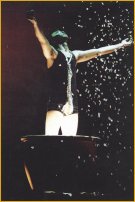 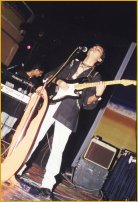 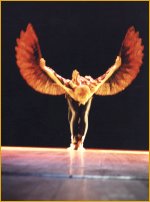 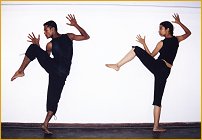 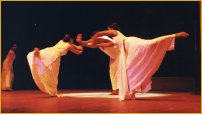 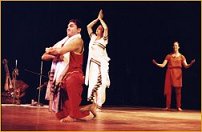 |